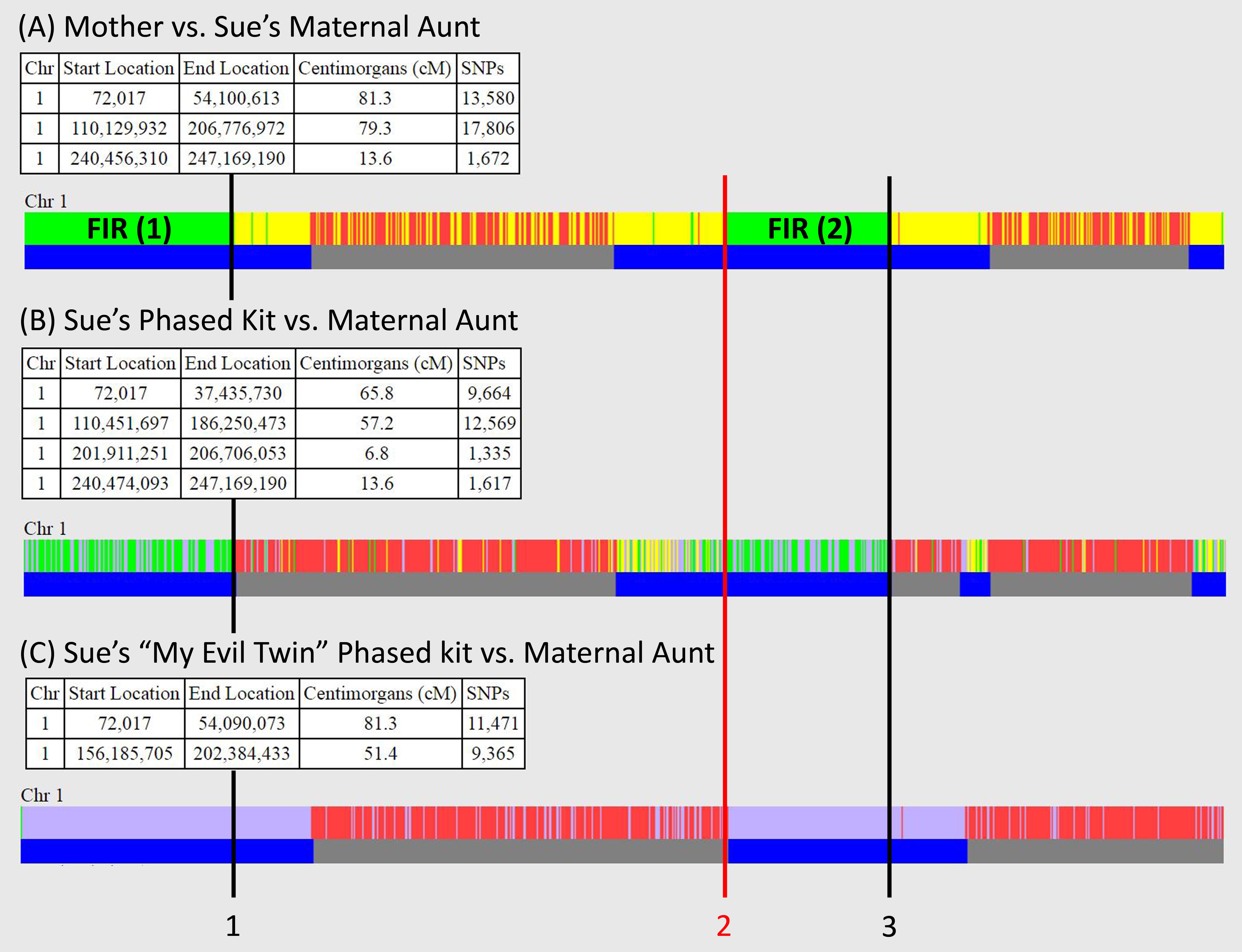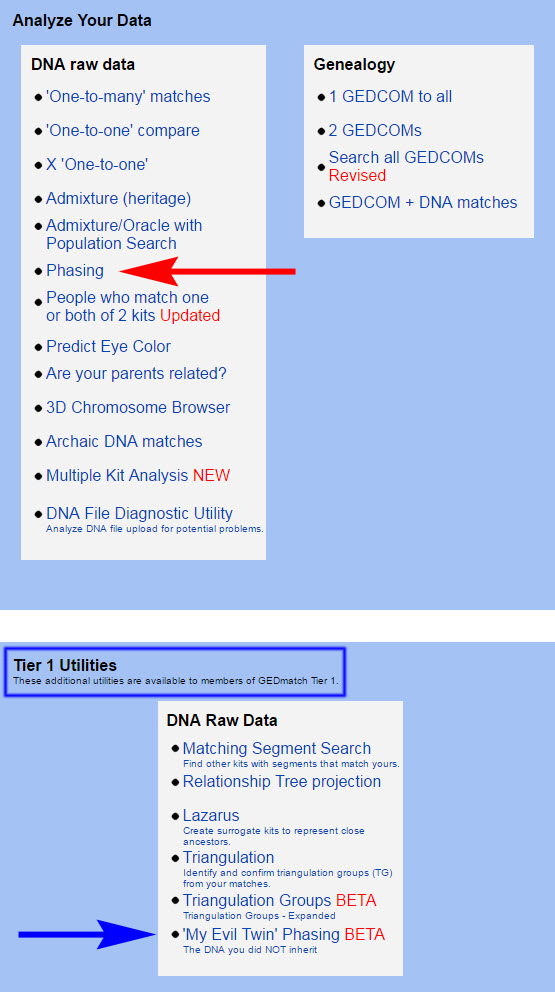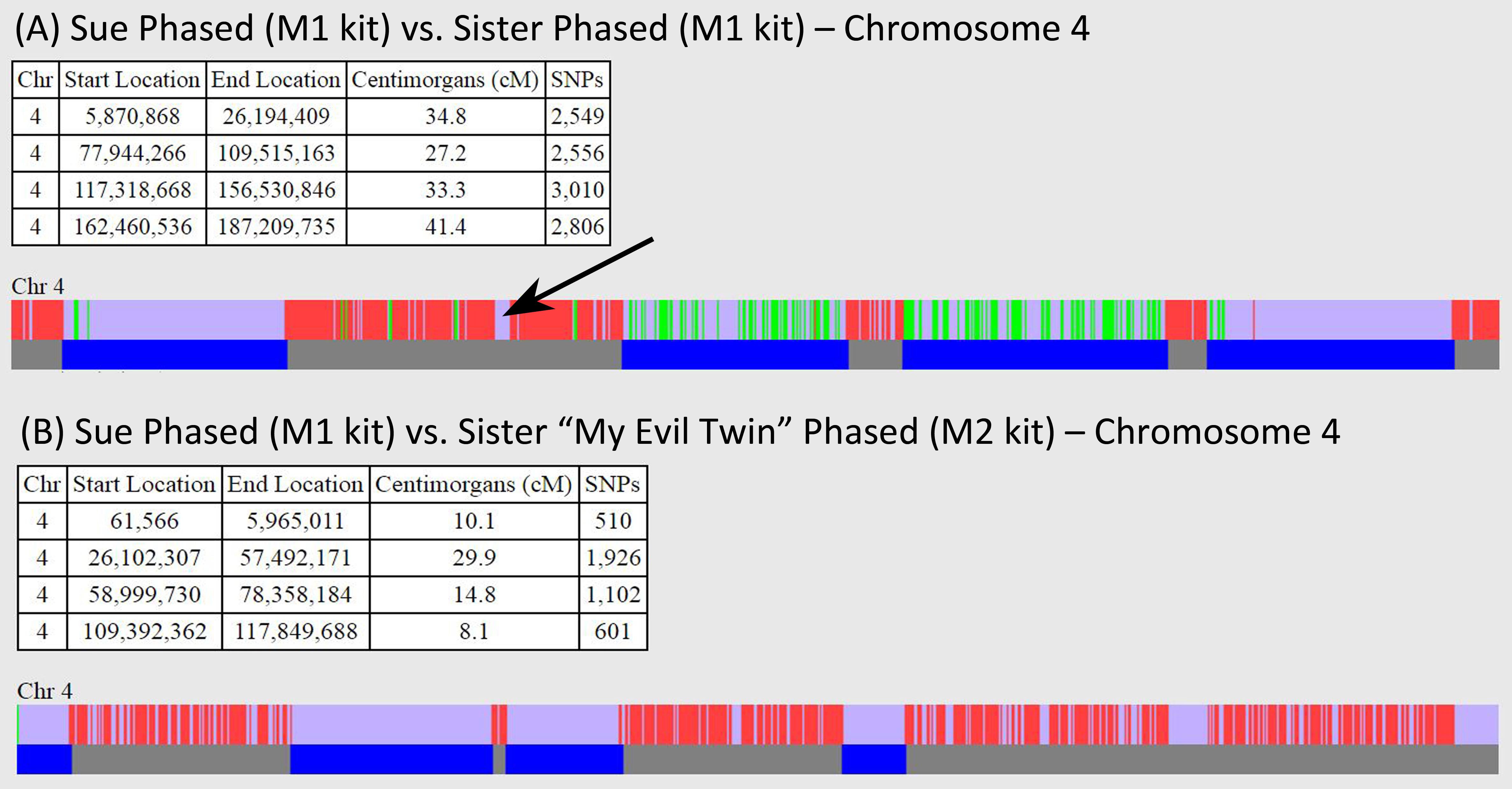- Panel (A) is the comparison between my mother and my maternal aunt (full-siblings), showing there are 2 FIRs, the green bars labeled FIR (1) and FIR (2). The table above the graphic gives the boundaries for the HIRs (half-identical regions), the blue bars, but not for the green FIR bars.
- Panel (B) is the comparison between my maternally-phased kit and my maternal aunt. This shows that my phased kit provides the end location of my mother's/aunt's FIR (1) at 37,435,730 (black line 1) and the end location of my mother's/aunt's FIR (2) at 186,250,473 (black line 3).
- Panel (C) is the comparison between my maternally-phased "evil twin" kit and my maternal aunt. This shows that "my evil twin" phased kit provides the start location of my mother's/aunt's FIR (2) at 156,185,705 (red line 2).
|
Figure 2 shows where to access the Phasing Tool and the "My Evil Twin" Phasing Tool on the GEDmatch Home page. Having phased data means that each of the pair of alleles in the raw data is assigned to either the maternal or paternal side, which reduces false positive matches – see the ISOGG Wiki Phasing page for more information.
[Note: Although there is no charge for using most of the tools on GEDmatch, additional "Tier 1" tools are available for a small donation of $10/month.] |
- The "normal" Phasing Tool at GEDmatch requires a person to have at least one their parents tested (and better still, both). Whether one or both parents have been tested, once the tool has been run (it only needs to be done once), 2 additional kit ID's will be created and will show up on your Home page, which will start with a "P" (for phased), followed by your kit number, and then will end in either "P1" for paternally-phased or "M1" for maternally-phased. For example, if the phasing tool is run on kit # A989898 with 1 or 2 parents, the paternally-phased kit # would be PA989898P1, and the maternally-phased kit # would be PA989898M1.
- The "My Evil Twin" Phasing Tool produces kit #'s for the DNA that has NOT been inherited from one or both parents. Again it only needs to be run once. But in contrast to the above, your father must have been tested in order to create a "my evil twin" paternal kit and your mother must have been tested in order to create a "my evil twin" maternal kit – if only one parent has been tested, you will only have the "my evil twin" kit for that side. "My evil twin" kit #'s again start with a "P" (for phased), followed by your kit number, and then will end in either "P2" or "M2" for "my evil twin" paternally- or maternally-phased, respectively. For example, if the "my evil twin" phasing tool is run on kit # A989898, the paternally-phased kit # would be PA989898P2, and the maternally-phased kit # would be PA989898M2.
Other Uses of Phased in Combination with "My Evil Twin" Phased Kits
Using a combination of both phased and "my evil twin" phased kits allows very short segment matching segments between siblings to be identified, thereby revealing pairs of crossovers that may easily be missed. Figures 3 and 4 shows one-to-one matching of my sister's and my kits for Chromosomes 4 and 21, respectively:
- Panel (A): My maternally-phased (M1) kit versus my sister's maternally-phased (M1) kit
- Panel (B): My maternally-phased (M1) kit versus my sister's maternal "evil twin" (M2) kit, which is equivalent to my maternal "evil twin" (M2) kit versus my sister's mternally phased (M1) kit
In contrast, Panel (B) of Figure 4 confirms that the purple segment (red arrow) in Panel (A) is NOT a legitimate matching segment on Chromosome 21. Again, I lowered the defaults in the phased M1 vs. M1 comparison and was able to "fudge" an apparently matching segment of 1.7 cM at the red arrow, which in this case is meaningless.
So Figures 3 and 4 illustrate how useful a phased M1 vs. an "evil twin" M2 comparison can be when looking at siblings. For anyone doing visual phasing using Kathy Johnston's method (see the PDF with Blaine Bettinger's recent 5-part series of great blog posts on this at Visual Phasing), I recommend ALWAYS using phased kits for the comparisons of siblings if they are available – not only do they identify the side (paternal vs. maternal) of the inherited crossover, but they also give more precise estimates of the location of the crossover. And using the "my evil twin" kits, otherwise hidden crossovers can be identified, which is especially useful when only 2 siblings are being compared.
The "my evil twin" phasing tool is amazing, although the utility of this may not be immediately apparent. GEDmatch provides all sorts of tools we don't even realize we need!
Although most of the tools on GEDmatch are free, don't forget that it is not a commercial enterprise and relies on donations for server and other costs. Please consider a donation via Paypal (if at least $10, it will give you access to Tier 1 tools for a month, allowing you to try them out) – there is a link at the bottom of your Home page. Donating helps all of us, as it enables GEDmatch to enhance what they can offer, such as the new "My Evil Twin" Phasing tool.





